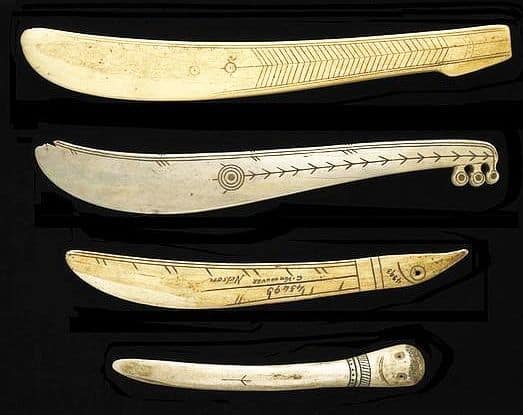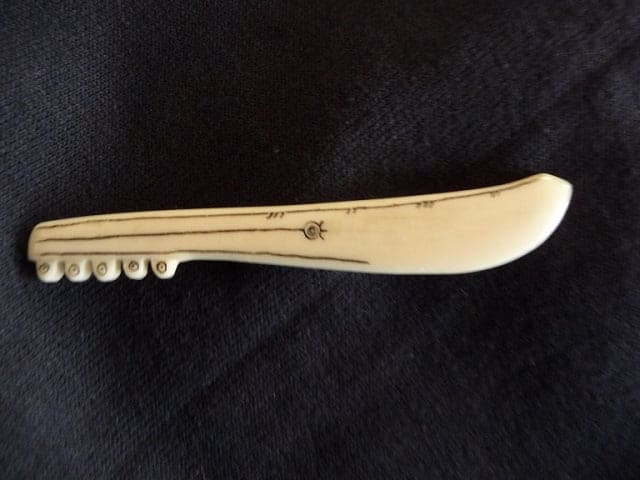(This site is reader-supported. When you buy something using retail links on our articles, we may earn a small commission. As an Amazon Associate I earn from qualifying purchases.)
A snow knife, as the name indicates, is a knife designed to use in snow. It is primarily used by the Eskimos to build their snow houses, the igloos. An igloo is a snow house built by the Inuit, a group of culturally similar aboriginals inhabiting the Arctic areas of Alaska, Canada, and Greenland. These people make it as a temporary shelter on prolonged hunting trips during winter.
An igloo is always built using snow. It takes around twenty to thirty minutes to make this shelter. However, the exact duration depends on snow quality and the builder’s skills. Making one such house involves cutting blocks of snow from snowbanks, which are then organized to form a dome featuring a single spiral design.
Using a snow knife, an Inuit maker gets the best blocks from a snowbank created by just one snowstorm. If taken from banks made by a chain of storms, the blocks are at the risk of breaking due to the snow layers.
Snow knives are utilized for not only cutting but also trimming the blocks of snow. Originally, they were made of ivory, horn, or bone and featured a trivial curve to the blade. Later, when the Europeans introduced metal the Arctic, the Inuit started making these knives featuring single-edged blades of steel.
Overview

Not very long ago, snow was the primary material of construction in the Canadian North. At that time, the locals used their hand-designed non-metallic snow knives to scrape ice as well as cut blocks from compacted, hard snow and pruning them for fitting them together.
Also known as the snow saw or pana, a snow knife refers to one of the construction tools used for making igluit or snow houses. It is also a weapon for the Arctic’s Inuit inhabitants. Its design is a broad-bladed curved tool having a handle at whose proximal end lies a final projection.
Less popular than the women’s ulu knife, a snow knife exclusively as well as ordinally a man’s tool. Its ax-like blade was used for a variety of chores, ranging right from flying fish to cutting hair. Unadorned and designed using walrus ivory or exported steel, this knife was also used as an ice-scraper.
When it was the matter of igloo construction, it was only this tool that was used as an instrument. The original knives were made usually using the reindeer’s shin bone or hon. However, with the advent of metal, the later versions were made using copper, iron, and steel.
Around King William Island in Canada’s arctic region of Nunavut, you can spot the legendary snow knives of hammered copper blades or refurnished scrap iron uncovered from the ruined John Franklin’s ships used on his expeditions. Their blades have a shape of a dagger and are double-edged, while the handles are made using musk-ox and horn roughly affixed by sinew lashings.
In the Pelly Bay area of the arctic Nunavut, you are most likely to spot a knife made by the Inuit people using animal bone and a handle carved with zigzag lines. Alaskan or Canadian snow knives of the 19th to early 20th century were multipurpose tools that were also used digging for berries and telling stories.
They were typically made using Walrus tusk with bone riveted using iron rivets to it at the handle. These iron rivets were perhaps obtained from old nails of packing cases that the visitors had deserted.
Few more models of the 19th century were carved from antler and featured a spearhead shape as well as a hole through their handles. They were worn on a string put around one’s neck, which is a great way to have a knife while building in the dark in haste amidst winds and with cold, numb hands.
Those made up of iron were believed to be more convenient in different ways. However, they are more susceptible to break when it is extremely cold during winter.
Many original snow knives have scratched tribal markings, which indicate the pride of the craftsmen. It is striking to see these adornments, which were engraved adorably even in harsh conditions by consuming several hours.
However, today, the Inuit people have the convenience of using more durable contemporary materials due to which they enjoy the benefit of less construction time as well as effort.
Types of Snow Knives

Yaaruin Story Knife

Yaaruin is conventionally a girl’s toy using which pictures are drawn in the snow or on the ground. The depictions show people, animals, houses, clothing, and events, which are a part of a story or a game wherein the participants are required to identify the artist’s subject.
These knife stories were often escorted by songs. Even today, the girls in the arctic region play this game using metallic knives instead of the traditional bone, wood, or ivory yaaruin.
The knife has its origin in the lower Alaskan area of Kuskokwim, wherein an old method of teaching the Yupik community was implemented. The teaching was done through fables or stories. While grandparents told bedtime stories to their kids for imparting cultural values, girls outside used to spin legends not only orally but also visually.
This was when the snow or mud acted as the paper, while the story knives made using ivory, wood, or bone were the pencils. Creative symbols typically related to a specific hamlet or a region became artworks. This is how their values, oral tales, and art was shared and preserved.
Edward William Nelson, an explorer and a weather observer from the U.S. Army Signal Corps, termed this play knife as the yaaruin snow knife. As a result, a story knife was conflated with the original Inuit pana. While it is the cause of confusion, it was easy to remove the confusion by distinguishing the knives based on their uses.
Elegantly adorned story knives carved from driftwood, antler, caribou rib, or walrus ivory were as versatile as the modern Swiss Army knives. They usually had a machete-style blade to teach the young siblings in forms of stories and songs. They challenged the spectators with puzzles for improving their abstraction and verbal skills while dulling the effects of frightening events.
Mothers and grandmothers used to wield the curved blade, at times, to share their fables with keen children. A simple reset separated drawings or scenes wherein the user wiped the existing depiction with the flat of her story knife blade, which was much like turning the page of a storybook.
Many yaaruins made using ivory have extraordinarily fine engravings, which allows identifying a story knife based on adornment. However, they do not have a carved handle unlike the other on ivory story knives with minimal adornment.
These knives show a variety of engravings on different sides such as drummers, dancers, and audience both standing and sitting on the benches along with the four Qasgi sides. Qasgi represents the Alaskan men’s square dwelling made using logs.
Especially remarkable is the creative way in which these carvings on a side of the Qasgi are tailored to fit the restricted space, with the back and lower legs wrapped around the knife’s rear at the top and their heads at the bottom.
The opposite side shows a series of dog sleds carrying folks, Eskimos atop a Qasgi, and a caribou skin on a parching rack. For carving and engraving on ivory, the material was first softened by drenching it in urine, and then the etched areas were blackened using a combination of blood and gunpowder.
Story knives are still seen in Yukon-Kuskokwim Delta hamlets along with boots, strong games, and igloos. However, they seem to be waning in terms of use.
Just as the ulu, a story knife is an ingenious icon that connects generations. Even today, if used, it defines male and female realms. The knives that adults use signifies the role of improvisation in the local, physical survival, girls’ empowerment, and language survival.
Conclusion
A snow knife is a tool primarily used for making temporary igloos although it is likely to be used for many other purposes by the Arctic inhabitants. Originally made up of antler, wood, or ivory, its later versions were made using metals such as copper, iron, and steel.

Hi, I am Jay. I am the creator of Knife Guides, your one-stop site for everything related to knives. I am a computer engineer by profession, knife aficionado by passion. Here I work with a group of people who’ve always had a passion for knives and blades. Over the years we’ve kind of become experts and decided to share our knowledge and ideas. I am also an avid hiker and enjoy offshore gamefishing.

